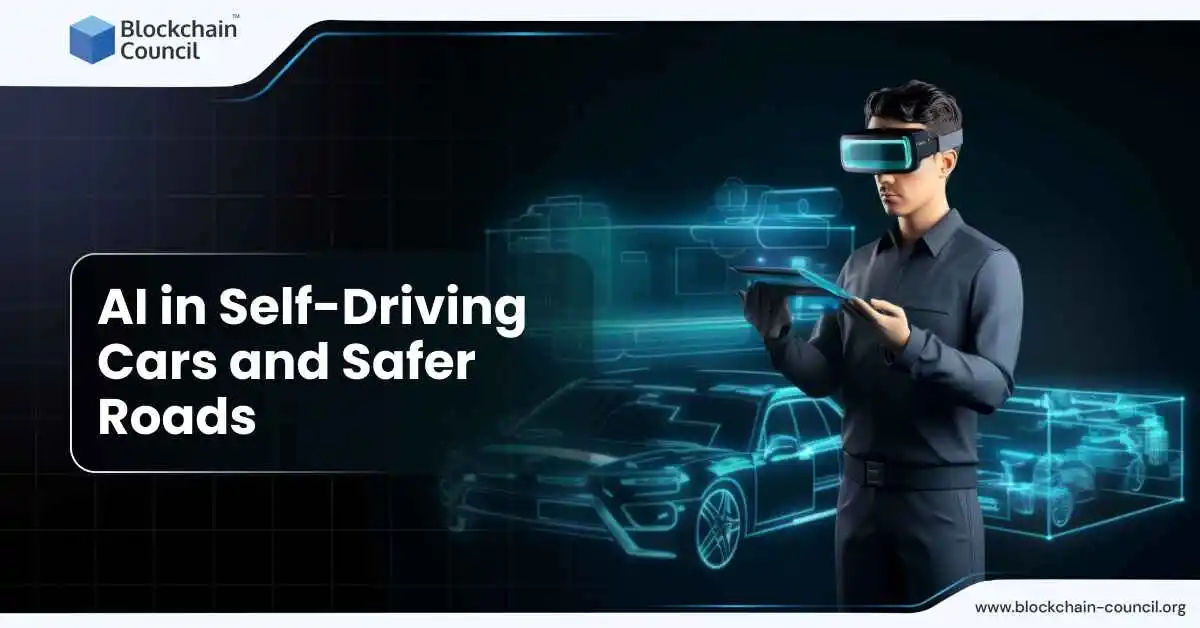
- Blockchain Council
- October 28, 2024
Artificial intelligence (AI) has made a noticeable impact across various industries, and its role in self-driving vehicles is especially important. As of 2024, AI continues to influence the future of road safety and driving, improving the way cars operate without needing constant human oversight.
AI’s Role in Autonomous Vehicles
Self-driving vehicles rely heavily on AI to make tough decisions while driving. AI systems manage key tasks like identifying obstacles, steering, and stopping by collecting data from tools such as sensors, cameras, and radar. These systems examine the surroundings and predict possible actions of other vehicles and pedestrians to keep everything safe. For instance, AI-powered vehicles can recognize people walking across the road and react instantly.
Many car manufacturers have prioritized AI in their efforts to develop self-driving cars. Recently, Volvo released its all-electric EX90 SUV, showcasing advanced AI tech to improve both road safety and driving performance. This car uses NVIDIA’s powerful computing platform, capable of handling up to 250 trillion operations per second. It processes real-time information to monitor surroundings and adapt driving behavior. This system is designed to lower the chances of accidents by creating a virtual safety bubble around the vehicle, especially useful in busy city areas.
For instance, companies like Waymo and Tesla are at the forefront of this technology. Waymo’s autonomous taxis in Arizona, which operate without human drivers, demonstrate the potential of AI to navigate complex urban environments with minimal accidents. Tesla’s Full Self-Driving (FSD) beta, although still under development, continues to make strides by refining its vision-based AI system, which eliminates the need for LiDAR (a common sensor used in autonomous vehicles). Both companies contribute to reducing human error on the roads, which is responsible for a large percentage of accidents globally.
AI-Powered Safety Features in Self-Driving Cars
AI improves safety in self-driving vehicles by integrating advanced driver-assistance systems (ADAS). These systems use AI to stop accidents by applying brakes, controlling speed, or staying in lanes when needed. Tesla, a key player in this field, continues to enhance its FSD system, aiming to make driving less risky by improving how AI handles real-world driving challenges. Tesla’s AI software lets its cars spot and avoid obstacles, people, and other cars accurately, lowering the chances of human error.
Volvo’s EX90 goes even further by adding lidar, a laser-based system that can detect objects up to 250 meters away, even when visibility is poor. The car merges AI with lidar, cameras, and radar, building a comprehensive system that continuously scans the area and makes rapid decisions to avoid crashes. These advancements in AI-driven features are making vehicles more capable of handling both expected and sudden road challenges.
Getting the Certified Artificial Intelligence (AI) Expert™ certification can help you understand how AI is used to improve self-driving cars and make roads safer.
AI’s Role in Reducing Traffic Accidents
A large number of accidents happen due to human mistakes, like losing focus or making poor judgments. By adding AI to vehicles, manufacturers are trying to eliminate common accident causes. AI systems in self-driving cars work without getting tired, distracted, or influenced by emotions, making them more consistent at staying alert. They can detect dangers faster and respond more quickly than a human driver would.
The increasing use of AI in cars is already showing positive results. Data from recent trials of AI-controlled self-driving cars highlight improvements in road safety overall. Bosch, a global technology company, is partnering with Microsoft to refine AI’s ability to assess real-time road data. This work aims to improve a vehicle’s decision-making process in difficult traffic situations. The collaboration focuses on making AI systems more resilient so they can deal with rapidly changing environments like heavy traffic or unexpected roadblocks.
Regulatory Progress and Challenges
While AI in self-driving cars holds promise for safer roads, getting regulatory approval remains a challenge. Governments across the world are cautiously moving forward in allowing fully autonomous cars on public roads. In 2024, the UK introduced the Automated Vehicles (AV) Act, setting safety standards and regulatory guidelines for self-driving cars. This law is part of a broader effort to ensure self-driving cars meet strict safety requirements before being widely adopted.
Countries such as the United States and China are also working on regulations that balance innovation with safety concerns. Both nations have launched pilot programs allowing limited autonomous vehicle use, especially in controlled settings like delivery services or public transport. These early-stage trials give manufacturers and researchers a chance to test safety features while collecting valuable data to enhance AI technology.
What’s Next for AI in Self-Driving Cars
In the coming years, AI development will focus on how self-driving cars interact with their surroundings. These cars will need to better understand human behavior, road conditions, and traffic patterns. This will require more advanced sensors and AI systems that can predict actions and respond quickly in tricky situations.
Companies like Tesla and Volvo are pouring resources into training AI systems to improve the decision-making ability of their vehicles. For instance, Volvo is using NVIDIA’s DGX AI platform to speed up the creation of AI models for its cars. This supercomputer helps train AI by processing massive amounts of data, allowing cars to adapt faster to changing driving conditions and improve their safety features.
The future of AI in self-driving cars holds great potential for fewer accidents and better traffic flow. However, challenges like regulation and public confidence must be addressed before self-driving vehicles become widespread.
Final Thoughts
AI continues to play a crucial part in the evolution of self-driving cars, bringing improvements in road safety and driving assistance. By integrating AI technology with advanced sensors, lidar, and real-time data processing, vehicles are becoming more reliable and safe. While there are still challenges related to regulations and public perception, progress made by companies like Tesla, Volvo, and Bosch indicates that AI-powered vehicles could soon become more common on the roads.


































































 Guides
Guides News
News Blockchain
Blockchain Cryptocurrency
& Digital Assets
Cryptocurrency
& Digital Assets Web3
Web3 Metaverse & NFTs
Metaverse & NFTs
